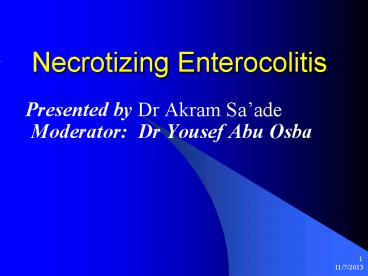Necrotizing Enterocolitis - PowerPoint PPT Presentation
1 / 23
Title:
Necrotizing Enterocolitis
Description:
Necrotizing Enterocolitis Presented by Dr Akram Sa ade Moderator: Dr Yousef Abu Osba History Ahmed is a newborn male baby , a product of caesarean section at 27 ... – PowerPoint PPT presentation
Number of Views:955
Avg rating:3.0/5.0
Title: Necrotizing Enterocolitis
1
Necrotizing Enterocolitis
- Presented by Dr Akram Saade
- Moderator Dr Yousef Abu Osba
2
History
- Ahmed is a newborn male baby , a product of
caesarean section at 27 week gestational age
due to antepartum hemorrhage on 28 July 2003 in a
major hospital in Amman.
3
Cource in the referral hospital
- The baby was immediately admitted and treated as
a case of - -Respiratory Distress Syndrome.
- -Suspected Sepsis.
4
Course in the referral hospital
- Put on mechanical ventilator.
- Covered by Ampicillin and ceftazidime.
- Given Pentaglobin.
- Received 3 doses of surfactant.
- Received packed RBCs and plasma many times.
5
Course in the referral hospital
- Feeding started at the age of 10 days but 2
days later the baby noticed to have abdominal
distentionfollowed by bluish discoloration of
the skin overlying the abdomen and scrotum. - Feeding stopped.
- Metronidazole added.
6
The baby referred to our NICU
- At the age of 3 weeks as a case of
- Prematurity.
- Respiratory Distress Syndrome.
- Cholestatic Jaundice.
- Suspected Retroperitonial Hemorrhage.
- Suspected IntraventricularHemorrhage.
7
Course in our NICU
- The baby continued on mechanical
- ventilator with the following setup
- RR 15 PiP 12
- FiO2 100 PEEP 3
- with gradual weaning according
- to the respiratory status.
8
Examination
- Vital signs
- HR 140 bpm
- RR 40/min
- BP 75/39mmHg
- Temp 35.9 C
9
Examination
- Head and Neck
- Pale.
- No dysmorphic features.
- No cyanosis.
- Normal neck examination.
10
Examination
- Chest
- No deformities.
- Good air entry bilaterally.
- Normal vesicular breathing.
- No added sounds.
11
Examination
- Cardiovascular
- Normal 1st and 2nd heart sounds.
- No murmurs.
- Intact peripheral pulses.
12
Examination
- Abdomen
- Distention, abdominal girth23cm.
- Bluish discoloration of the skin overlying
- the abdomen.
- Palpated mass about 2cm in diameter
- just below the left costal margin.
- Bilateral inguinal hernia.
- Scrotal swelling with bluish discoloration
- of the overlying skin.
13
Investigation
- WBC14.9 x 10 9 N65 L25
- PCV36 PLT75x10 9
- Na132 meq/l K4 meq/l
- Ca8.5 mg/dl CRP48
- TSB8.1mg/dl Direct bilirubin3.5mg/dl
- ABGs pH7.45 PaO2186
- PaCO236 HCO324
14
Imaging
- Chest X-Ray
- Resolving respiratory distress syndrome.
- Abdominal Ultrasound
- Bilateral hydronephrosis ,Fluid collection.
- Head Ultrasound
No hemorrhage.
Chest
15
Management
- NPO and NGT free drainage.
- Central line.
- IVFthat was changed according to blood glucose
and electrlytes . - Packed RBCs and Plasma.
- Metronidazole,Imipinem and Teicoplanin.
- Pentaglobin.
- Vitamin k.
16
- Necrotizing Enterocolitis suspected and
abdominal erect and supine X-rays done and
revealed
Multiple air fluid levels with air under the
diaphragm ,which suggested a perforated hollow
viscus.
17
Pediatric surgeon consultation
- Peritoneal drainage performed, the drained
peritoneal fluid was bloody, dirty
and under pressure initially about
50cc. - Peritoneal lavage done with Cefotaxime and
saline.
18
- Drain removed 5days later after clearing and
decreasing in amount of the discharge. - Follow up X-Rays revealed ---no air
fluid levels
-disappearance of air under the diaphragm.
19
Course in the hospital
- 10 days after admission
Abdominal Ultrasound repeated and
revealed - disappearance of fluid collection.
- improvement of hydronephrosis.
20
Course in the hospital
- 2 weeks after admission
-The general condition was significantly
improved but unfortunately the condition - deteriorated with development of metabolic
and respiratory acidosis for which sepsis
workup done that were all negative apart from
growth of klebsiella from the ETT. - Imipinem and Teicoplanin discontinued.
- Ceftazidime and Amikacin started.
- Fluconazole added.
- Pentaglobin given.
21
Course in the hospital
- In the last 3 days
- The patient developed cardiopulmonary
compromise for which
Dopamine and Dobutamine and NaHCO3 continuous
infusion started . but the baby
continued to have bradycardia and metabolic
acidosis.
22
Course in the hospital
- Inspite of continuous intensive
management ,the condition deteriorated
and the patient resuscitated
for 3 times - Died on 3 AUGUST 2003.
23
Final Diagnosis
- Prematurity.
- Respiratory Distress Syndrome.
- Necrotizing Enterocolitis.
- Cholestatic Jaundice.































